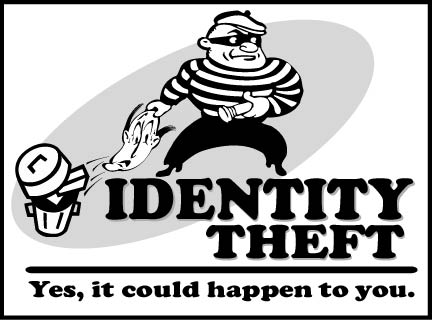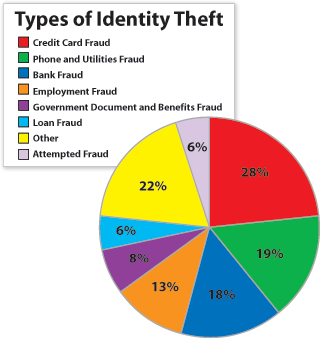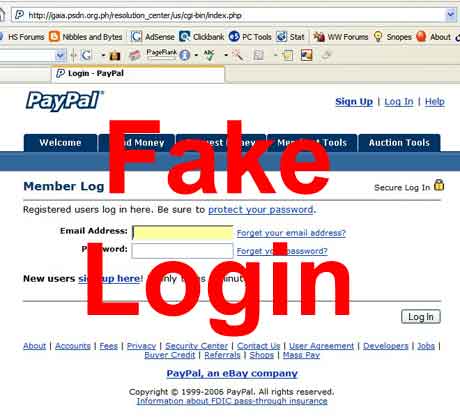Courses/Computer Science/CPSC 203/CPSC 203 2008Winter L03/CPSC 203 2008WinterL03 TermProjects/T19 Group 3- Identity Theft on Ebay
Contents
Project Information
Team Name
CILK
Group Members
Karly Cyr, Jenn Irwin, Brittany Knievel, Alex Loach
Initial Project Statement
Throughout this presentation we will discuss identity theft, and more specifically identity theft on Ebay. Including how criminals manage to steal another person's entire identity, how to prevent it from happenning to you, PayPal, and specific examples of people who have been victims of identity theft. 
How Identity Theft Happens
Thieves can steal the identity of others in a variety of ways. Through the internet, also known as online "phishing", they can pretend to be a valid company and request that you send them your contact or credit card information. They can also use a computer to hack your records, or even find this important information by simply rummaging through the trash.ID thieves also steal mail containing bank and credit card information, or even worse, they may fill out a change of address form in your name so that they receive all your mail. Another identity theft technique is "skimming". This is when theives connect a data storage device to an ATM, this device will collect all your information when you swipe your card. Fianlly there is direct theft, they can simply steal your wallet or purse in order to gain your financial information.
How Identity Theft Happens on Ebay
Identity theft is present on Ebay, however not as frequent as one might think. Less tan 0.01% of all transactions on Ebay are confirmed cases of fraud. Identity thieves can create a fraudulent auction and then act as a bidder in order to force an innocent buyer to raise their bid. Once the buyer “wins,” the thief will disappear with the money. They can send an e-mail to all Ebay users requesting their password in order to complete a recent transaction. Sometimes they may even ask for a credit card or driver’s license number. When an innocent customer responds, the thief takes over their account. Thieves may also use a software that scans all Ebay users to find those who rarely use their accounts. It then proceeds to enter a series of passwords, if it is successful in entering the account, the thief can then take over to users identity. Since the software targets infrequent users, it is not as likely they will discover someone has taken over their account.
How To Prevent it on Ebay
Although you can never prevent identity theft entirely, there are still a few ways that you can minimize the risk that it will happen to you. First, before revealing your personal information you need to find out how the information will be used and if it will be shared with others and if so, who. Pay close attention to your billing cycles. Notify creditors if your bills do not arrive on time. Exercise the passwords on your credit card, bank and phone accounts often, and try to avoid using easily available information such as mother’s maiden name, birth date, or phone number as a password. Also, minimizing the number of identification information and then number of cards you carry will decrease your risk of having somebody stealing your identity. If possible, do not give your information out over the phone. Keep your information in a safe place and be sure to rip up any receipts, copies of credit applications, insurance forms, physician statements and credit offers you get so that an identity thief cannot search through your garbage and find all that information. Only give your SIN out when it is absolutely necessary. Last but not least, do not carry your SIN card around with you, keep it in a safe and secure pace.
Case Studies
"When it happens to you, you wonder what else did they get? What allowed this to happen, and what else is in jeopardy?"
This simple quote from an identity theft victim (via eBay) echoes the fear and unnerving that one may suffer when this crime happens to them.
This can't happen to you, though, can it? These average people who thought the same have told their stories:
A woman, Dian, who is very adept at using computers, and who knows of all the potential problems one can encounter if they are not safe, had her identity stolen via eBay. Dian had never used eBay, but when she was made aware of a bargain she could get for a “kitty condo”, saving over $200, she could not resist. Her purchase went smoothly, and soon she found herself browsing eBay for more bargains. Upon finding a bargain for a parrot cage, Dian attempted to log on so she could bid. When she could not log on, Dian recalled an email she had received a few days earlier, one that had someone claiming Dian needed to pay for an auction that she had won. Dian recalled no such auction, but, thought it may have been a mistake on her part, so she clicked the link in the email, typed in her eBay account and password, and emailed the person back. Dian had opened a spoof email and had clicked a link to a bogus site which resembled the eBay login page, and someone had stolen her eBay account. Dian had been “phished”. Luckily for Dian, she used a different site (paypal) for financial means on eBay, and so, despite the scare, all she had lost was her eBay account.
Another girl, an eBay user, was innocently surfing the internet on a wireless internet connection when someone hacked in. The hacker identified her by her Hotmail account, and, upon realizing she was an eBay member, logged in to her eBay account, since it happened to have the same password as her Hotmail account. While both eBay and Hotmail recognized a security breach, they sent e-mails asking about suspicious activity to the girl’s Hotmail and backup email accounts, respectively. Of course, the hacker had gained access to both, and simply dismissed the companies’ concern. Luckily, this girl did not use paypal and so the thief could not access her bank details. The hacker did, however, set up a fake paypal account and spent over $500 in the girl’s name. After 72 hours, the girl finally suspended both accounts and eventually solved the problem.
PayPal
PayPal is one of the leading methods of online payment to have emerged onto the global market. The service enables anyone to make payments in different locations around the world, using different currencies, and a multitude of languages. Founded in 1998 in San Jose, California, PayPal was acquired by eBay in 2002 quickly becoming its' preferred and fastest method of payment for eBay users. Although PayPal claims to be one of the safest and easiest ways to make online payments using credit cards or bank accounts, there are many variables one must consider before signing up for a PayPal account. A great concern is that of identity theft, something that is increasingly common among internet users, especially online shoppers.
In many publicized identity theft cases, the issue of PayPal and its’ association with eBay has been looked at, discussed, and criticized many times. John Watson, of California, found himself embroiled in such a predicament last year with Bank of America and PayPal. When Watson discovered $7,600 was missing from his Bank of America account, he never assumed PayPal would be a contributing factor to this crime. Because PayPal allows anyone to open an account over the Internet, the background checks performed are very minimal; therefore, allowing identities to be stolen. In John Watson’s case, an imposter had opened a PayPal account in his name, and pulled money into that account from Watson's personal bank account. The theft had spent more than $5000 of the money he had transferred into the opened PayPal account. When Watson called the bank to investigate this matter they said there was nothing they could do. When Watson contacted PayPal they gave him the remaining amount from his initial $7600 but refused to help with the $5000 that had been spent. Bev, a frequent eBay and PayPal user, had her account hacked into and had been the victim of another identity theft crime. She had $800 taken from her account. A thief had found her email address, accessed her account, spend her funds, and eventually put her into debt.
Hacking into eBay accounts is quite common, and easy to do: a password isn’t even required. All you need is a credit card number and the corresponding email address. A theif hacked into Patrick Thomas’ PayPal account on eBay using an old credit card number Thomas had provided for his PayPal account. The theft sold bogus items and received the money from all sales. In the end, Thomas was held responsible for the crime and forced to repay PayPal the money which PayPal believed he had.
PayPal claims to have Buyer Protection Plan that protects eBay users from fraud, swindling, deception and imitation products. This protection provides purchase protection for buyers and helps buyers recover funds from eBay sellers who do not deliver the promised goods, or who deliver goods that are not accurately described in the listing. PayPal Buyer Protection also claims to cover payments for tangible, physical goods that can be shipped. Paul Bezaire, a frequent eBay and PayPal user purchased what he assumed to be a new VCR. Upon opening the package, he found a VCR that did not work: the switches on the front and back were broken and unusable. He contacted PayPal and they said he would have to submit documentation to prove the devise was broken in order for them to refund his money. After getting an appraisal for his VCR, he decided that it would be easier to keep the broken VCR and have it fixed then to send it back to eBay as he had to pay a sufficient fee for the troubles he had supposedly put eBay and PayPal through.
Conclusion
Identity theft is a frequent crime that people need to be aware of. It can happen to any unsupecting user of Ebay, so customers must take precautions so that they do not become a victim of a stolen identity.
References
http://en.wikipedia.org/wiki/Identity_theft
http://archives.cnn.com/2002/TECH/internet/02/18/ebay.identity.theft.idg/index.html
http://en.wikipedia.org/wiki/Ghosting_%28identity_theft%29
http://www.creditreport.com/identitytheft/info/how.asp (How does Identity Theft Happen?)
http://en.wikipedia.org/wiki/Online_identity
http://www.fraudguards.com/wp-content/upload%20folder/2006/11/identity-theft-piechart
http://en.wikipedia.org/wiki/Computer_crime
http://pages.ebay.ca/help/confidence/problems-identity-theft.html
http://en.wikipedia.org/wiki/Cybercrime
http://pages.ebay.ca/securitycentre/phonebusters.html
http://en.wikipedia.org/wiki/Phishing
http://www.phonebusters.com/english/recognizeit_identitythetips.html
http://en.wikipedia.org/wiki/EBay
http://www.safefromscams.co.uk/PreventIdentityTheft.html
http://en.wikipedia.org/wiki/Botnet
http://www.news.com/2100-1017-966835.html
http://archives.cnn.com/2002/TECH/internet/02/18/ebay.identity.theft.idg/index.html
http://pubs.logicalexpressions.com/Pub0009/LPMArticle.asp?ID=643
http://www.paypalwarning.com/home
http://www.msnbc.msn.com/id/4264051/
http://www.identitytheftfixes.com/paypal_is_declaring_a_war_on_identity_theft.html
http://antivirus.about.com/cs/emailscams/a/blebayscam5.htm
http://en.wikipedia.org/wiki/PayPal
http://en.wikipedia.org/wiki/American_Arbitration_Association
http://www.fraudguards.com/wp-content/upload%20folder/2006/11/identity-theft-piechart
http://www.hoax-slayer.com/images/paypal-scam-2
http://www.news.com/2100-1017-966835.html
http://pages.ebay.ie/help/confidence/problems-identity-theft.html
http://pages.ebay.ie/help/confidence/problems-identity-theft.html
http://news.netcraft.com/archives/2006/06/16/paypal_security_flaw_allows_identity_theft.html
http://www.fightidentitytheft.com/paypal_scam.html
http://ezinearticles.com/?Anatomy-of-A-PayPal-Identity-Theft-Scam---The-7-Warning-Signs&id=73439


